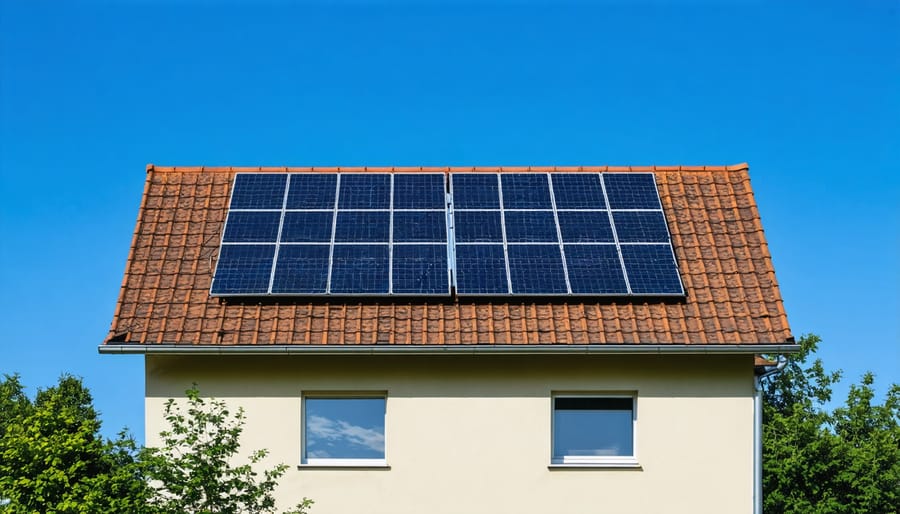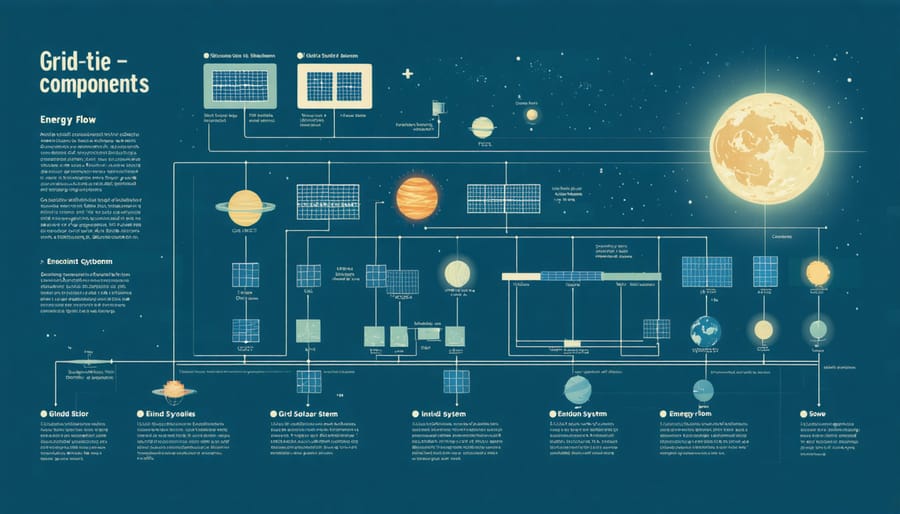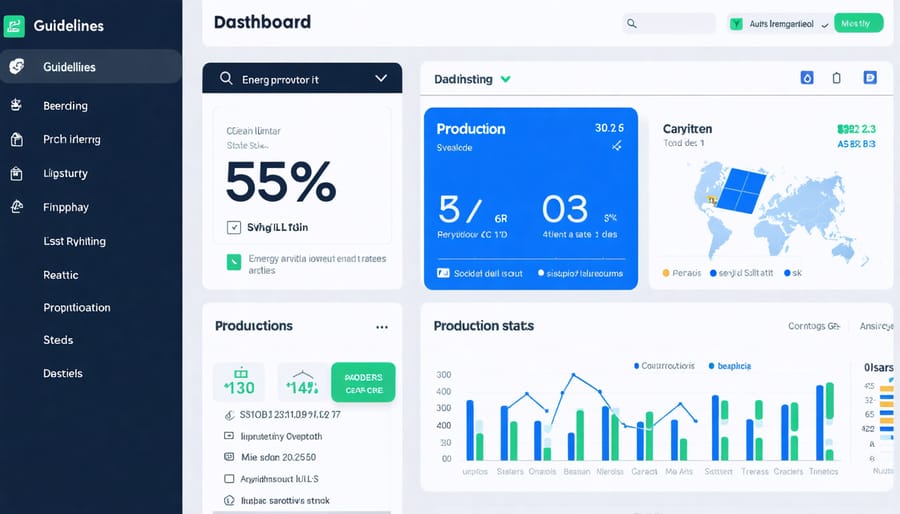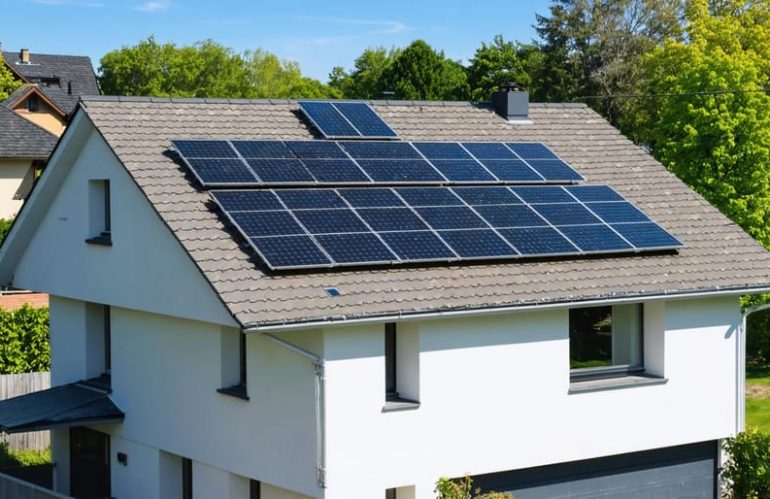A 5kW grid-tie solar system represents the perfect balance of power and practicality for modern homeowners seeking energy independence. As a cornerstone of residential solar power, these systems generate enough electricity to offset 70-80% of the average household’s energy consumption while maintaining a reliable connection to the utility grid. By producing approximately 20-25 kWh of electricity daily, homeowners can dramatically reduce their energy bills while contributing to a more sustainable future. The system’s grid-tie feature ensures seamless power transitions between solar and utility electricity, eliminating the need for battery storage while allowing excess energy to be fed back into the grid for additional savings through net metering programs. Whether you’re looking to reduce your carbon footprint, protect against rising energy costs, or increase your home’s value, a 5kW grid-tie solar system offers a proven, cost-effective solution that typically pays for itself within 5-7 years.
Why 5kW Grid-Tie Systems Are Perfect for Most Homes
Power Output and Home Coverage
A 5kW grid-tie solar system typically produces between 15-25 kWh of electricity per day, depending on your location and available sunlight. This output is ideal for households consuming 500-800 kWh per month, effectively covering the energy needs of an average family home of 1,500-2,500 square feet.
During peak sunlight hours, your system will generate maximum power, often producing surplus energy that flows back to the grid. This excess production helps offset your nighttime usage when the system isn’t generating power. In most locations, a 5kW system can offset 70-90% of a household’s annual electricity consumption.
The system’s actual performance varies with factors like roof orientation, panel tilt angle, and local weather patterns. Southern-facing installations typically yield the best results, while partial shade can reduce output by 10-25%. Modern solar panels include power optimizers or microinverters that help minimize these losses and maintain consistent energy production.
To maximize your system’s benefits, consider timing your major appliance usage during peak solar production hours, typically between 10 AM and 2 PM. This practice ensures you’re using your generated power directly rather than drawing from the grid.
Space Requirements and Installation
A 5kW grid-tie solar system typically requires about 300-400 square feet of unshaded roof space, depending on the panels’ efficiency and layout. This area usually accommodates 15-20 standard solar panels, which can be arranged in various configurations to match your roof’s dimensions and orientation.
For optimal performance, panels should face south in the Northern Hemisphere, though southeast and southwest orientations can still provide excellent results. Your roof should have a pitch between 30-45 degrees, though modern mounting systems can adjust the angle if needed.
Installation typically takes 2-3 days and requires professional expertise. The process involves mounting rails, installing the panels, connecting the inverter, and establishing proper grounding. Your roof should be in good condition and structurally sound to support the additional weight, which is approximately 3-4 pounds per square foot.
Before installation, ensure your electrical panel can handle the system’s output and that local building codes and HOA regulations permit solar installations. Most installers will handle necessary permits and inspections as part of their service.

Smart Grid Integration Benefits

Net Metering Advantages
Net metering is one of the most attractive benefits of installing a 5kW grid-tie solar system, essentially turning your electric meter into a two-way counting device. When your solar panels produce more electricity than you’re using, the excess power flows back into the grid, causing your meter to run backward. This surplus energy creates credits on your utility bill.
During peak sunlight hours, your 5kW system often generates more power than needed, especially when you’re away from home. This excess energy offsets the electricity you draw from the grid during nighttime or cloudy days when your panels aren’t producing enough power. The result? Significant reductions in your monthly utility bills.
The financial benefits of net metering are substantial. Many homeowners see their electricity bills drop by 50-90%, depending on their energy consumption patterns and local sunshine levels. Some even achieve a net-zero electricity bill during particularly sunny months. This arrangement ensures you get full value for every kilowatt-hour your system produces.
Beyond immediate savings, net metering also protects you against future utility rate increases. As electricity prices continue to rise, the value of your solar-generated power increases proportionally. It’s like locking in today’s electricity rates for the next 25+ years, providing long-term financial security and predictable energy costs.
Grid Support Features
Modern 5kW grid-tie solar systems come equipped with advanced features that enhance grid stability and provide smart energy management capabilities. Through smart grid integration, these systems actively contribute to maintaining power quality and grid reliability.
The system’s inverter includes anti-islanding protection, automatically disconnecting when grid power fails to ensure utility worker safety. Power factor correction helps maintain voltage stability, while harmonic filtering reduces electrical noise that could affect sensitive equipment. These features make your solar installation a good neighbor on the power grid.
Real-time monitoring allows you to track energy production and consumption through user-friendly mobile apps. Many systems include automated power curtailment, which adjusts output based on grid conditions and your home’s energy needs. During peak demand periods, the system can help reduce strain on the grid while maximizing your energy savings.
Most modern installations also feature reactive power support, helping to maintain consistent voltage levels in your neighborhood. This capability, combined with sophisticated frequency regulation, means your solar system not only generates clean energy but also helps create a more resilient and stable power grid for everyone.
Real Cost and Savings Analysis
Initial Investment and Incentives
A 5kW grid-tie solar system typically requires an initial investment of $12,000 to $15,000, though prices can vary based on location and installation costs. This investment covers solar panels, inverters, mounting hardware, and professional installation. While this might seem substantial, various financial incentives significantly reduce the overall cost.
The federal solar tax credit currently allows homeowners to deduct 30% of their solar installation costs from their federal taxes. Many states offer additional tax incentives, rebates, and grants that can further lower the initial investment by 10-20%. Some utility companies also provide performance-based incentives or solar renewable energy certificates (SRECs).
Net metering programs enable homeowners to earn credits for excess energy production, effectively reducing monthly utility bills. When combined with rising electricity rates, most 5kW systems achieve payback within 5-8 years. Many manufacturers offer warranties extending 25 years, ensuring long-term value.
Financing options like solar loans, leases, and power purchase agreements (PPAs) make solar installations more accessible, often requiring little to no upfront cost. These options allow homeowners to start saving on energy bills immediately while paying for their system over time.
Long-term Financial Benefits
A 5kW grid-tie solar system represents a significant long-term investment that typically pays for itself within 5-7 years, depending on your location and energy consumption patterns. With average installation costs ranging from $15,000 to $20,000 (after federal tax incentives), homeowners can expect to save between $100 and $200 monthly on electricity bills, translating to annual savings of $1,200-$2,400.
When you factor in rising utility rates, which historically increase by 2-3% annually, the financial benefits become even more compelling. Over a 25-year period (the typical warranty lifetime of solar panels), total savings can exceed $50,000. To maximize your energy ROI, consider that many states offer additional incentives, such as Solar Renewable Energy Credits (SRECs) and property tax exemptions.
The system also adds substantial value to your property, with studies showing home values increasing by approximately $15,000 with a 5kW installation. Additionally, modern grid-tie systems often come with performance guarantees and minimal maintenance requirements, ensuring consistent returns on your investment while protecting against future energy cost increases.
System Monitoring and Maintenance
Smart Monitoring Solutions
Modern solar energy management systems transform your 5kW grid-tie setup from a simple power generator into a smart energy solution. These monitoring platforms provide real-time insights into your system’s performance through user-friendly mobile apps and web interfaces.
You can track daily energy production, monitor panel efficiency, and identify potential issues before they impact performance. Many systems offer automated alerts for maintenance needs and detailed reporting of energy savings. This data helps you optimize your solar investment and maximize returns.
Weather forecasting integration allows these smart systems to predict upcoming energy production, helping you plan your power usage more effectively. You can also monitor your home’s energy consumption patterns and adjust habits to maximize solar power utilization.
Most monitoring solutions now include remote access capabilities, letting you check on your system from anywhere. This feature is particularly valuable for detecting unusual performance drops or celebrating peak production days. Some advanced platforms even integrate with home automation systems, allowing for intelligent power management across all your household devices.
These monitoring tools make managing your solar investment simple and rewarding, while ensuring optimal system performance year-round.

Maintenance Requirements
A 5kW grid-tie solar system requires minimal maintenance, making it an ideal choice for homeowners. Regular cleaning of the solar panels every 3-4 months helps maintain optimal performance by removing dust, leaves, and bird droppings. This can typically be done using a garden hose or soft brush during cooler morning hours.
Annual professional inspections are recommended to check electrical connections, mounting hardware, and inverter performance. These inspections help identify and address potential issues before they affect system efficiency. Most inverters have monitoring systems that alert you to performance changes, making it easier to spot problems early.
After heavy storms or extreme weather events, it’s wise to visually inspect your panels for any damage. Snow generally melts off panels naturally, but you may need to clear heavy accumulation using appropriate safety equipment. Keep surrounding trees trimmed to prevent shading and falling branches.
The inverter, which typically has a lifespan of 10-15 years, may need replacement before the panels themselves, which can last 25-30 years with proper care. Maintaining clear documentation of system performance and service history helps track efficiency over time.
Future-Proofing Your Investment
When investing in a 5kW grid-tie solar system, you’re not just buying for today – you’re investing in your energy future. One of the most appealing aspects of these systems is their modular nature, allowing for strategic expansion as your energy needs grow. Whether you’re planning to add an electric vehicle to your household or anticipating increased power consumption, your initial 5kW setup can serve as a foundation for future expansion.
Modern grid-tie inverters are designed with technological evolution in mind, featuring firmware updates that can be installed remotely to enhance performance and add new capabilities. Many current systems also come with smart monitoring capabilities that can be upgraded over time, helping you stay current with the latest energy management features.
To future-proof your investment, consider selecting components with standardized connections and working with installers who use industry-standard mounting systems. This approach ensures that adding panels or upgrading components in the future won’t require a complete system overhaul. Additionally, many contemporary systems are battery-ready, meaning you can add energy storage capabilities later without significant modifications to your existing setup.
The rise of smart home technology and grid modernization efforts means your solar system can become increasingly integrated with home automation systems and participate in emerging energy markets. Look for systems that offer compatibility with common communication protocols and have the potential to integrate with virtual power plants and grid services programs, which could provide additional revenue streams in the future.
Remember to check that your electrical panel and roof structure can accommodate future expansions, ensuring your home’s infrastructure won’t limit your system’s growth potential.
A 5kW grid-tie solar system represents a smart investment in your home’s future and the environment. By harnessing clean, renewable energy, you’ll significantly reduce your monthly electricity bills while increasing your property value. The system’s ability to seamlessly integrate with the existing power grid ensures reliable power supply while allowing you to contribute excess energy back to the community.
The financial benefits are compelling, with many homeowners seeing a return on investment within 5-7 years through reduced energy costs and available tax incentives. Beyond the monetary advantages, you’ll be reducing your carbon footprint and taking meaningful action against climate change, with a typical 5kW system preventing approximately 4-5 tons of CO2 emissions annually.
Ready to make the switch to solar? Begin by getting quotes from certified installers in your area who can assess your specific needs and roof configuration. Remember to review local regulations, available incentives, and financing options. Most importantly, choose a reputable installer who can ensure proper system design and installation.
With energy costs continuing to rise and environmental concerns becoming increasingly urgent, there’s never been a better time to invest in a 5kW grid-tie solar system. Take the first step toward energy independence and sustainability by scheduling a solar consultation today. Your wallet and the planet will thank you for years to come.









